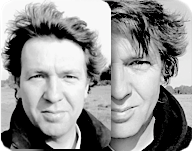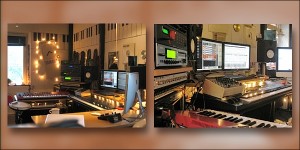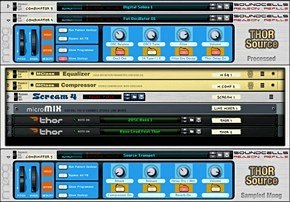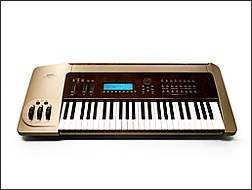Soundcells
Exclusive interview with Harald Karla – the Reason Refill maestro at Soundcells
Steelberry Clones got an exclusive talk with the critically acclaimed Reason Refill producer Harald Karla at Soundcells. Soundcells has been active for a long time in developing quality Refills for Propellerhead’s DAW Reason, many of which has been featured and reviewed on this blog. Soundcells’ Reason Refills covers most angles of electronic music – featuring everything from 8-bit / chip tune type sounds to high quality emulations of classic analog hardware synthesizers like Moog Source to the KORG MS-20, but also a vast amount of very complex ambient pads that would fit any sci-fi movie on the planet. We at Steelberry Clones are happy users ourselves of Soundcells ever growing library of Reason Refills and therefore we thought it about time to dive a little bit deeper into the minds of Soundcells by asking Harald Karla who founded the company in 2008 all those questions that make up the unique sounds of the Soundcells’ Refills. Harald Karla have worked as a successful freelance sound designer for quite some time but is now focusing on Soundcells full time.
You can visit Soundcells webshop via this link to find out more about the various Reason Refills of Soundcells or simply use the Soundcells banner in the right hand side column to explore further >>>>
You have been active making Reason Refills for a long time – where do you find your inspiration
First and foremost, Soundcells ReFills are products that meet my personal taste. And that is an inspiration and first of all motivation – not just to create a product that the market demands immediately, but to follow your own preferences. Since I prefer to be within Reason, I’m trying to do everything possible there, of course. Also this is the reason for the content of the ReFills. The more I can put in a single environment – the more energy, concentration and creativity remains for the music …
When producing the Refills you often stay true to the original analog synths, for example the MS-20, how do you go about re-creating these sounds
Well – actually that is not my intention to emulate certain classics – it’s more the intention to preserve the typical sound characteristics. “Analog Signature” for example is a ReFill, essential to sample those classics – which thus serve as a sound basis and shaping the sound of the ReFills. In this ReFill the analog sound-feeling is in the foreground, and therefore the sampling here was comparatively expensive: In order to have vibrant aesthetics of sound each individual note is played three times and recorded. The capabilities of the NNXT sampler can be heard by repeating a note played on the same sample twice in a row …
The result is a vivid sound that raises a very analog feeling. One should not forget that real analog sounds are not only created by “fluctuating” oscillators, but also generated by other components such as filters, envelopes, modulations of various kinds. And here some analog synthesizer sounds incredibly strong, which can not be done simply by multi-sampling individual notes … At this point, it simply ends the emulation. If you wanted to create the typical sound with all its inaccuracies of the original, it would ultimately imply sampling note for note – very expensive and a different topic …
The Soundcells studio
We know of you as a high-end producer of Reason Refills and more, but can you tell us a little more about your musical background
A story of many – I had a very early interest in the creation of sounds, and in the beginning I did experiment with various instruments, but very early on I ended up focusing only on electronic instruments. From the time of the summer jobs I put all my money in (initially) keyboards, then synthesizers, drum machines, mixers, effects, etc.
I have never taken any lessons. The keyboard I’ve taught myself and I have always played by ear. Over the years I have dealt extensively with many types of music and electronic sounds, later on I started to create backing tracks to produce dance music with DJs, etc. … – And then finally spent all my time in music. Basically, the years were something of a “full study,” which continues to this day … : 0)
Do you make any electronic music yourself and if Yes in what capacity
I have published three albums under the name “Jonson”:
“Chiplandschaften”, “p_composing” und “Mindlook” – three very different albums, but all in the area of Ambient / Chillout …
Unfortunately, due to the work at Soundcells there is little time to actually work on a fourth album – but that’s still at the top of my “priority list” going forward.
Any favorite electronic bands/acts that has inspired you in your musical adventure
When I was young I consumed everything that was in the charts – basically same as everyone else. There were of course in different phases individual artists who accompanied me musically longer, and it was not just electronic music. But what have always been there to inspire me, is and was the sound of synthesizers:
And in looking back nothing has really changed my preference for synthetic sound has remained, and is as all alive today!
For inspiration: everything what one hears, sees and experiences, affects, and is being implemented in some way. Some use this color, while others write books … I use them to music and sounds.
You seem to have a fascination not only of analog synths but also for more chip type style sounds, as with the BitBumber Refill, are you active in this scene yourself and where lies the fascination of these sounds
I have never been active in this scene, but I can be quite fascinated with 8-bit sounds – such sounds often have enormous assertiveness and lots of character – lo-fi provides a very clean sound that is always very refreshing to listen to. This is similar to adding acoustic elements into an otherwise electronic production. In the past I often used 4 or 8-bit music loops in many of my productions, which were always something like “the icing on the cake”. Just coming back to one of my albums: “Chip Landscapes” – even if it sounds pure LoFi everything on this album has been implemented with a sampler, and this was 100% samples of an Amiga1200 with a mere 15 MB of data: 0)))
Are you using a lot of real samples in your production process or do you create most of it from scratch
If you really want to capture the essential characteristics of a specific analog synth it need to be sampled, otherwise you will not capture the full sound spectrum. Sometimes you also want to record real samples as a snippet of something bigger. Such fragments may be the basis for a sound that is not so easily created by synthesis or any other way for that matter.
In the case of “Thor Source” ReFills you may also find that the reverse is true as well:
Thor will be used to build the Moog Source – which has worked out extraordinarily well. The advantage of creating sounds on the basis of Reason’s sound generator (or synthesizers in general) is of course always the universal access to the various parameters and also their modulation.
Do you have any favorites in the new Reason 6 release, and if Yes what are they and why
I really welcome all new additions in the Reason suite: What I favor depends a lot on what I want to accomplish at a certain point, sometimes it is the hearty Pulverizer that defines the result, or in other cases it is just the good sounding and widely adjustable Echo Effect. My current favorite is the Alligator that is truly more than just a “Gater effect for trance music” – But in general the best thing in Reason are the free routing possibilities between the units included whether it is an effect unit or synthesizer.
You produce not only for the Reason platform, how does it differ for you working on other platforms
My main platform is and remains Reason. Let me put it this way:
The ability to share samples and synthesis within the Combinators and add appropriate effects is of real value, moreover all participating devices can influence each other to make all the difference. Even after years using Reason, I feel the Combinator is still a real “weapon” – it is in fact a very powerful way to compile and control everything.
Something other platforms do not offer. Ultimately, however, the platform does not matter – apart from personal preference, I use the particular circumstances, to make the best of it, rather than complaining the a lack of it.
Is there anything you miss or lack in Reason 6
Like many others, I also miss Midi Out: It would be a blessing to be able to control the hardware directly via Reason, rather than use another sequencer only for this. VST I do not miss – the limited range of devices in Reason allows a significantly higher concentration of the input, and promotes – as always when there is less – your creativity
Any favorite hardware synths in your studio – that you will not let go of, and why
Although it is too little used, my Yamaha VL1 will probably never leave the studio: It is still very fascinating to see how organic and almost acoustic sounds this synthesizer can make. But there are several hardware synths that have not been in vain: The Rozzbox One V2 has a very unique lo-fi character, the Nord Modular G2x, with its extremely turbulent and dense ambient textures … I could continue this list a little : 0
The Yamaha VL1 was the first synth to utilize 100% physical modeling technology, according to the definition of physical modeling given earlier. It generates all waveforms completely from algorithms, without using samples or any acoustic input. The waveforms are generated based on math models of the acoustics of physical instruments, which allows for some very expressive playing, and a new way of relating to a synth. I think that pretty much everyone who has seriously investigated the state of the art of physical modeling in early ’96 would agree that the VL1 is the clear technology leader, considering only commercially available equipment. While the VL1 will no-doubt go down in synth history as a landmark achievement in a bold new technology that promises to bring new dimensions to musical performance, it has its problems. The fact that Yamaha has been unable to get accurate, or even usable simulations in many of its voices, and the fact that other manufacturers who invested significant R & D in physical modeling have been unable to come near Yamaha’s achievement, should give you some idea of how difficult it is to do physical modeling well. In addition, the VL1 can be challenging to play if a musician wants to use the controllers and realize even part of what the new technology offers. In the same breath, let me point out that the learning curve on the VL1 is much easier than what you would have with real acoustic instruments.
What is your take on the explosion of iOS based soft synhts and instruments – can they replace the originals going forward
A fascinating area in terms of basic development, but certainly not a replacement – and why should they replace existing and functioning tools, just because it’s now also on an iPad? I like it a lot more if the new platforms are used in order to make things possible that would otherwise be difficult or impossible. In this direction there will be more and more, and this is where I think the iPad is very exciting. I’ve recently been granted one myself, and when I look at the “Animoog” – this has been really something, and sounds even more: 0)
But so far – based on what is coming in the next few years, this area is probably still to refer as “in its infancy”.
When can we expect something new to arrive from the Soundcells factory
The currently free Nordic Red ReFill will be inflated a lot in the next few weeks, and probably in April or May matured into a full version. And in the mean time there will be a monthly update of an existing ReFill. To what extent there will appear a new product, next to the Nordic Red ReFill, this year is is to early to say – it ultimately takes a lot of time and resources to produce a good sound set. Surely it would be possible to create small 25-patch-ReFills for 10 € – that could happen every month – but I see little sense in such mini-sets.






